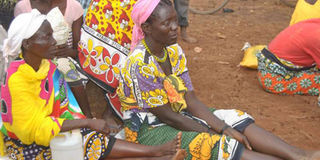Food crisis to worsen, agency warns

Residents waiting for relief food in Ganze, Kilifi County, on October 26, 2016 following a prolonged drought that has hit many parts of the country. PHOTO | CHARLES LWANGA | NATION MEDIA GROUP
What you need to know:
- Narok, Kajiado, Taita-Taveta, Kilifi, Kwale, Tana River, Kitui, Makueni, Marsabit and Garissa counties are experiencing a decline in food and livestock production as well as water supply.
- Food shortage has been aggravated by conflict in some counties, the most serious case in the previous month being along the border of Isiolo and Garissa, where pastoralists’ convergence is common.
- The onset of the dry spell in the North Rift has sparked fears of conflicts in the scramble for scarce resources among pastoralists.
An agency monitoring drought has warned of a worsening food crisis in the country should the dry spell being experienced persists.
“If the (short) rains are below average, as currently forecast, or the onset of the season is late, then the situation will become significantly worse, with impacts on health and nutrition, household purchasing power and security,” the National Drought Management Authority (NDMA) says in its latest bulletin.
The document further says: “The implications of a poor season are particularly worrying for marginal agricultural counties, which are short rains-dependent.”
The authority issued drought alerts for 10 counties and an alarm for one.
The authority said Narok, Kajiado, Taita-Taveta, Kilifi, Kwale, Tana River, Kitui, Makueni, Marsabit and Garissa counties were experiencing a decline in food and livestock production as well as water supply. The drought status of Lamu was moved up from alert to alarm.
In its October bulletin, the authority says only one county — Kilifi — was in the alarm drought phase, with the rest in the alert phase.
The authority’s chairperson, Ms Agnes Ndetei, said in parts of Kilifi, Garissa, Lamu, Kwale, Taita-Taveta, Tana River, Makueni, Kajiado, Narok and Marsabit, there are now significant shortages of pasture and water.
“Areas in the south-east and the Coast are the most affected since they received below-average rainfall during the long rains season,” said Ms Ndetei.
According to the agency, the food shortage has been aggravated by conflict in some counties, the most serious case in the previous month being along the border of Isiolo and Garissa, where pastoralists’ convergence is common.
DROUGHT CONTINGENCY PLANS
“NDMA, in collaboration with county governments and other stakeholders, has activated drought contingency plans in seven counties and is supporting all devolved units to coordinate their response and plan for a possible La Niña event,” says the bulletin.
The authority says it has disbursed Sh53 million of drought contingency finance provided by the European Union in seven counties since the beginning of July.
The onset of the dry spell in the North Rift has sparked fears of conflicts in the scramble for scarce resources among pastoralists in the region.
A spot check by the Nation revealed that many water sources in the area had dried up and pastures depleted, prompting pastoralists to move with their livestock to neighbouring areas.
This has been witnessed in Mochongoi Forest, Baringo; and Laikipia Nature Conservancy, where Pokot herders have moved with hundreds of their livestock.
Baringo county commissioner Peter Okwanyo said they were in talks with elders in the region for pasture committees to be constituted to avoid conflicts.
A report released by the Kenya Food Security Steering Group and Early Warning Systems Network in January indicates that families in Samburu, Marsabit, Isiolo, Garissa, Mandera and Wajir faced food shortages and inadequate pasture and water for their animals due to the dry spell.
Thousands of families in parts of Baringo, West Pokot and Turkana counties in the North Rift region are also experiencing food shortages that are likely to be complicated by the drought.




